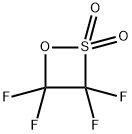
2-(Fluorosulfonyl)difluoroacetic acid synthesis
- Product Name:2-(Fluorosulfonyl)difluoroacetic acid
- CAS Number:1717-59-5
- Molecular formula:C2HF3O4S
- Molecular Weight:178.09
2,2-Difluoro-2-(fluorosulfonyl)acetic acid can be used as organic synthesis intermediates and pharmaceutical intermediates, mainly for the preparation of anti-HIV compounds. It was prepared from NaOH, tetrafluoroethane-beta-lactone in deionized water stirred for overnight at room temperature.

107-46-0
457 suppliers
$10.00/10g

677-67-8
21 suppliers
inquiry

420-56-4
71 suppliers
$95.00/10 g

1717-59-5
213 suppliers
$15.00/1g

120801-75-4
150 suppliers
$37.20/1g
Yield:120801-75-4 85%
Reaction Conditions:
Stage #1:Hexamethyldisiloxane;fluorosulfonyldifluoroacetyl fluoride at 0 - 100.6; under 4350.44 - 5925.59 Torr; for 18 h;
Stage #2: with chloro-trimethyl-silane at 20 - 107.8;Product distribution / selectivity;Heating / reflux;
Steps:
1; 3; 4 Preparation of RSUTMS
A 600 ml autoclave is cooled in ice water, evacuated, and charged with hexamethyldisiloxane (294 ml, 220 g, 1.36 moles) and RSU (255.3 g, 1.42 moles). The autoclave is then heated at 100° C. for 18 hours; the pressure rises to a maximum of 100 psig (0.79 MPa). The reaction mixture is cooled to room temperature and a black liquid (471.4 g) is removed from the autoclave.The product above, and another prepared in substantially the same manner, are combined in a 2 L flask and distilled using a water-cooled condenser and a dry ice trap between the vacuum source and distillation apparatus to trap co-product trimethylsilyl fluoride. Results of the distillation are summarized in Table 1. TABLE 1 Head Temp Pressure Fraction No. (° C.) (mm Hg) Weight (g) Dry ice trap - - 254.3 1 23-40 760 6.9 2 24-65 25 157.6 3 65-67 25 488.4 Heel - - 5.8 Fractions 2 and 3 are RSUTMS containing 8.4 mole % RSUA. Yield of RSUTMS is 86.9% based on HMDS, the limiting reagent, which is substantially all converted in the course of the reaction. A one liter autoclave is charged with hexamethyldisiloxane (243.5 g, 1.50 moles) and then purged with nitrogen, cooled, and evacuated. RSU (286 g, 1.59 moles) is then added at 1.9° C. The autoclave is then heated to 100.6° C. over the course of about one hour with 600 rpm agitation; the pressure rises to a maximum of 69 psig (0.58 MPa). The reaction is stirred at 100° C. for six hours and then cooled to room temperature. The crude product (521 g) is removed from the autoclave; the concentration of RSUA relative to RSUTMS is about 7.7 mole %. 1H NMR shows HMDS conversion to be about 97%.The product is transferred to a 500 mL flask fitted with a vacuum-jacketed Vigreux column and a cold finger distillation head. Volatile components (RSU and fluorotrimethylsilane) are removed from the mixture by distillation at atmospheric pressure up to a pot temperature of 127.6° C. The pot is allowed to cool to room temperature and then CTMS (41.7 g, 0.384 mole) is added to the pot. The flask is then heated at atmospheric pressure to a maximum of 107.8° C. as excess CTMS distilled overhead. The pressure in the distillation is then reduced and RSUTMS is recovered. The heart cut (320.6 g) contains about 3.3 mole % RSUA. Yield of RSUTMS is 85% based on HMDS converted in the six hour reaction time. Following the procedure of Example 3, RSU (428 g, 2.38 moles) is contacted with HMDS (361.8, 2.25 moles) for 6 hr at 95° C. After discharge, 1H NMR analysis of the crude product indicates the presence of 0.20 mole % HMDS, 48.1 mole % FTMS, and 51.7 mole % RSUTMS; the conversion of HMDS is about 99.6%. 19F NMR analysis of the crude product indicates that the relative amount of RSUA to RSUTMS is about 3.0 mole %. The crude products from this reaction and another carried out in substantially the same manner (but with a reaction temperature of 110° C.) are combined (1558 g total) and distilled at atmospheric pressure to remove low-boiling components. Chlorotrimethylsilane (126.04 g) is added to the distillation pot and the mixture stirred overnight and then distilled at a pressure of about 370 to 380 mbar (37 to 38 kPa). The pressure of the distillation is then reduced to 33-36 mbar (3,3-3.6 kPa). After a small fore-run (59 g), the product (1008 g; 87.7% yield based on HMDS charged) is collected at head temperature of 59.3 to 61.3° C. at a pressure of 33 to 36 mbar (3.3 to 3.6 kPa). The RSUA content of the product is mole 1.4 mole %.
References:
Sievert, Allen Capron;Sprague, Lee G. US2007/270602, 2007, A1 Location in patent:Page/Page column 3-4

697-18-7
76 suppliers
inquiry

1717-59-5
213 suppliers
$15.00/1g

697-18-7
76 suppliers
inquiry

7732-18-5
462 suppliers
$12.69/100ml

1717-59-5
213 suppliers
$15.00/1g

677-67-8
21 suppliers
inquiry

1717-59-5
213 suppliers
$15.00/1g

677-67-8
21 suppliers
inquiry

7732-18-5
462 suppliers
$12.69/100ml

1717-59-5
213 suppliers
$15.00/1g